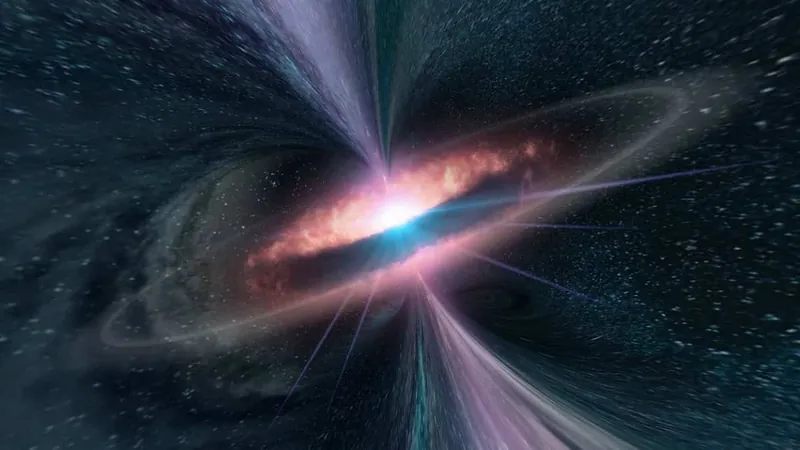
Massive Black Hole is Gorging on a Giant Star, Unleashing Unprecedented Radiation!
2024-11-03
Author: Jia
Introduction
In an astonishing discovery, astronomers have detected a colossal black hole, weighing in at six times the mass of our Sun, in a cosmic feast on a massive star located a staggering 20,000 light-years from Earth. This breathtaking astronomical event is unfolding in the V4641 Sagittarii system, positioned in the direction of the Sagittarius constellation.
The Cosmic Encounter
The star being consumed is roughly three times the mass of the Sun and is currently in a dramatic collision course with the black hole. Researchers have reported that the resulting emissions from this cataclysmic encounter boast an incredible energy level of 200 teraelectronvolts (TeV)—a milestone not commonly observed outside of quasars, the extremely luminous centers of distant galaxies powered by supermassive black holes.
A Microquasar Unveiled
This discovery positions V4641 Sagittarii as a microquasar—a kind of miniature quasar that exhibits similar behavior, but on a smaller scale. Sabrina Casanova, from the Institute of Nuclear Physics Polish Academy of Sciences (IFJ PAN), remarked on the significance of this finding: "Typically, photons from microquasars possess energies on the order of tens of gigaelectronvolts. However, our observations revealed something extraordinary—a microquasar emitting photons with energies tens of thousands of times greater than usual."
The Science Behind the Detection of Gamma Rays
The remarkable gamma rays were detected using the cutting-edge High-Altitude Water Cherenkov (HAWC) observatory located on the slopes of the extinct Sierra Negra volcano in Mexico. HAWC is specially designed to detect high-energy particles and is equipped with 300 large steel tanks filled with purified water. When energetic particles interact with the water, they generate a cascade of secondary particles that outpace the speed of light in water, creating a phenomenon known as Cherenkov radiation—an electromagnetic equivalent of a sonic boom.
Transformative Observation Capabilities
At any moment, HAWC can observe 15% of the visible sky, making it capable of mapping two-thirds of the sky every single day. This impressive capability led researchers to identify V4641 Sagittarii when they scanned one of their cosmic maps. Physicist Xiaojie Wang noted, “While examining the sky maps for my next project, I stumbled upon a region five degrees away from our galactic plane that emitted bright signals. This was a previously unexplored region that could potentially reveal new astronomical phenomena.”
What Does This Mean for Astrophysics?
The implications of this research stretch far beyond mere curiosity. The high-energy emissions from microquasars like V4641 Sagittarii could provide valuable insights into the fundamental processes of high-energy astrophysics and the behavior of matter in extreme gravitational fields. Understanding how black holes interact with surrounding stars may help astronomers unlock the mysteries of galaxy formation and evolution, as well as the physics underpinning black hole growth.
Conclusion
As we continue to investigate these cosmic giants, the mysteries of the universe become a little clearer, and our understanding of the majestic forces that shape our cosmos expands. Buckle up, because the universe is far more exhilarating than we once imagined! Don't miss the next breakthrough in space exploration—stay tuned!




 Brasil (PT)
Brasil (PT)
 Canada (EN)
Canada (EN)
 Chile (ES)
Chile (ES)
 España (ES)
España (ES)
 France (FR)
France (FR)
 Hong Kong (EN)
Hong Kong (EN)
 Italia (IT)
Italia (IT)
 日本 (JA)
日本 (JA)
 Magyarország (HU)
Magyarország (HU)
 Norge (NO)
Norge (NO)
 Polska (PL)
Polska (PL)
 Schweiz (DE)
Schweiz (DE)
 Singapore (EN)
Singapore (EN)
 Sverige (SV)
Sverige (SV)
 Suomi (FI)
Suomi (FI)
 Türkiye (TR)
Türkiye (TR)